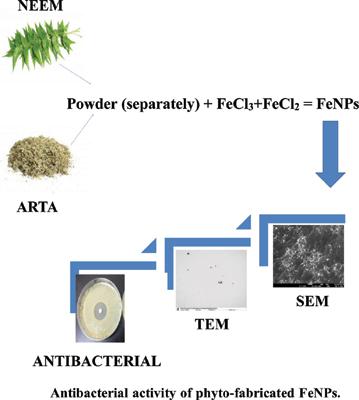Current Nanoscience ( IF 1.4 ) Pub Date : 2021-02-28 , DOI: 10.2174/1573413716999200817105934 Asma S. Algebaly 1 , Afrah E. Mohammed 1 , Mudawi M. Elobeid 2

|
Introduction: Fabrication of iron nanoparticles (FeNPs) has recently attracted considerable interest due to the varied applications of FeNPs in remediation technologies.
Objective: The current study aimed to develop a green technology approach to fabricate FeNPs by using extracts from two different plant sources, Azadirachta indica leaf and Calligonum comosum root.
Methods: A mixture of FeCl2 and FeCl3 was used to react with the plant extracts which are considered as reducing and stabilizing agents for the generation of FeNPs in one step. Spectroscopy and microscopy techniques were used for the characterization of the FeNPs.
Results: Immediately after mixing the iron solution and the plant extracts, the color of the solution changed to dark brown indicating conversion of Fe ions to FeNPs. This fabrication of FeNPs was confirmed by Zetasizer, transmission electron microscopy, and scanning electron microscopy. FeNPs fabricated by C. comosum were smaller than those fabricated by A. indica. For both plant sources, FeNPs fabricated using the aqueous extract were smaller than those fabricated with the ethanolic extract. Furthermore, antibacterial ability against two bacterial species was demonstrated.
Conclusion: This study provides evidence that plant extracts can fabricate Fe nanoparticles from Fe ions at room temperature. This technique has potential usage in large-scale production and antibacterial applications, including that it could be recommended for use against antibiotic-resistant bacteria.
中文翻译:

植物铁纳米粒子的制造:表征和抗菌能力。
简介:由于铁纳米颗粒(FeNPs)在修复技术中的各种应用,近来铁纳米颗粒(FeNPs)的制造引起了人们的极大兴趣。
目的:当前的研究旨在开发一种绿色技术方法,通过使用来自两种不同植物来源(印A(Azadirachta indica)叶和马尾Call(Calligonum comosum))的提取物来制备FeNP。
方法:使用FeCl 2和FeCl 3的混合物与植物提取物反应,该提取物被认为是一步还原FeNPs的还原剂和稳定剂。光谱学和显微镜技术用于FeNPs的表征。
结果:将铁溶液和植物提取物混合后,溶液的颜色立即变为深棕色,表明Fe离子转化为FeNPs。FeNPs的这种制备已通过Zetasizer,透射电子显微镜和扫描电子显微镜得到了证实。com。comosum生产的FeNPs比A. indica生产的FeNPs小。对于两种植物来源,使用水提取物制备的FeNP均比使用乙醇提取物制备的FeNP小。此外,证明了对两种细菌的抗菌能力。
结论:这项研究提供了证据,表明植物提取物可以在室温下从Fe离子制备Fe纳米颗粒。该技术在大规模生产和抗菌应用中具有潜在用途,包括可能被推荐用于抗药性细菌。











































 京公网安备 11010802027423号
京公网安备 11010802027423号